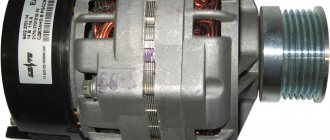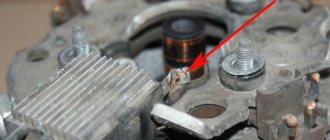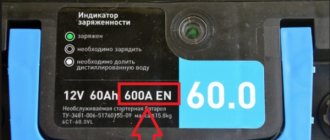Constant undercharging of the battery or its absolute discharge at the most inopportune moment is a headache for many car owners. One source of these problems may be the generator. But how to check it? Perhaps it's not his fault at all? Let's figure out together how much the generator must produce for the normal functioning of all car systems and maintaining the battery in a charged state.
How much should the generator produce to properly charge the battery?
Often, a car generator is not able to charge the battery on board the car to 100%.
And car owners don’t always know about this, and don’t even realize it. After all, a battery charged, for example, 70-80%, can also turn the starter and power the on-board network, although weaker and for less time than a fully charged one. To control battery charging from the generator, two quantities are used:
- Voltage (V, volts).
- Current, current strength (A, amperes).
Charging the battery in a car occurs only while the engine is running, when the generator rotates and generates electricity.
In this case, the battery should receive a voltage of 13.5V -14.5V.
The second most important parameter for charging is the current in amperes. This is where misunderstandings often occur. Initially, the battery and generator on the car are selected appropriately from the factory. At the factory, they install a battery of the exact capacity that can be fully charged by the standard alternator on this car model. But if the car owner then installed a new battery of a different capacity during the change, there may be inconsistencies.
Preparatory work
Before you begin the process of recharging the battery, prepare everything you need. First, decide whether you will remove the device from the car or not. If you remove it, it will reset all electronic settings. On the other hand, you can safely take it home and perform the procedure there.
If you have a garage or other place where you can store your car under protection, you can leave the battery in place. This option, among other things, will allow you to save all settings
However, here you need to treat the equipment with caution and not damage the current conducting elements
Secondly, prepare the device itself. Leave it in a warm room until it reaches approximately room temperature. If the car is stored in a heated garage, then there will be no problems, but if outside, then take care of the temperature conditions. You will also need special equipment for charging the car, which must have the function of controlling the current and supplying a certain voltage.
How much should the generator produce to properly charge the battery?
The balance of the battery and generator is determined by the simplest formula. The number of amps/hours of the battery is divided by 10.
For example, a car is equipped with a battery with a capacity of 100Ah. 100:10 = 10A. For a battery with a capacity of 60Ah, this figure is 6A. (60:10=6).
This is exactly the amount of current the generator must provide to recharge these batteries. For a battery with a capacity of 100Ah – 10 amperes, for a battery with a capacity of 60Ah – 6 amperes, and so on.
It is important that this ratio is relevant for charging with a generator during a trip. The charger can charge a battery removed from the car even at a current strength that is 2 times less.
For example, 3A instead of 6A for a 60Ah battery. But charging will occur twice as slow; during a trip with high energy consumption (light, climate control), the battery may simply not have time to charge. Modern chargers themselves determine the parameters of the charging current; the capabilities of the 220V network for such purposes are not limited, unlike a generator. In rare cases, the charger only has a switch for the required voltage - for batteries of 6, 12 and 24V.
Most often, a car is equipped with a battery with a larger capacity than the standard one. A battery with a smaller capacity may simply not pull the starter even when fully charged, especially in the cold season.
The dimensions of the installation site often allow this to be done, since the dimensions of batteries of different capacities sometimes differ slightly.
For example, a battery with a capacity of 72Ah has dimensions of 27.8 cm by 17.5 cm by 17.5 cm. And a battery with a capacity of 100Ah has dimensions of 35.3 cm by 17.5 cm by 19.0 cm.
The differences in the sizes of batteries with a smaller difference in capacity (70-80Ah) are almost imperceptible, or they are sometimes equal, so such replacements happen quite often.
When making such a replacement, you should check the current strength of the generator. It can be indicated in the Operating Instructions, in the technical specifications section. Also, the actual current strength can be measured with the engine running using a simple ammeter or multimeter. Such measurements of current and voltage may be required not only when replacing the battery with a more powerful one. They evaluate the generator's performance in any case. Sometimes it can work, but not to its full potential. For example, the belt slips, low speed, little energy, the battery is recharged, but not completely.
In critical cases, when the generator is completely out of order, the car owner will notice this very quickly. Firstly, according to the signal from the devices, “the battery is not charging,” etc. Secondly, because after a short distance “on one battery” the car will quickly stop.
But chronic “undercharging” can go unnoticed.
Charging control with a multimeter
For those who don’t know, this is a special miniature device, which is most often produced by our eastern neighbors. Its price on the market rarely exceeds 1000 rubles. The prefix “multi” means that it can measure a lot of useful things, but we are only interested in one parameter - voltage. It is its value that will allow us to draw conclusions about the performance of the generator. But before you check whether the battery is charging or not, it’s a good idea to make sure it’s working. Moreover, this can be done using the same multimeter.
Having measured the battery voltage in idle mode, i.e. without load, indirect conclusions can be drawn about the degree of its charge. To do this you need:
- Set the multimeter switch to the position corresponding to the measurement of direct current, with a limit greater than 12 V. The limit in the photo is set to 20 V, but it can be different for different types of measuring instruments. It should only be noted that the lower the limit, the greater the measurement accuracy;
- Connect the multimeter probes to the battery terminals. In this case, it is not necessary to observe polarity; the design of the device allows this. If the connection is incorrect, the voltage value will be displayed with a “-“ sign;
- Read the readings of the device and, using the data in the table, draw conclusions about the state of charge of the battery.
Once again, these are approximate values. More accurate data can be obtained only by measuring the density of the electrolyte. And, nevertheless, if the voltage test showed that the battery is charged less than 50%. it follows .
Now you can check the charging from the car generator. The sequence of actions is the same as in the previous case. The main difference is that the test is performed at idle engine speed. Therefore, safety precautions should be observed. The voltage on the battery, during normal operation of the generator and relay regulator, should be within 13.7 - 14.3 V.
Now you need to turn on the low beam headlights and heated rear window. The voltage on the battery may drop slightly, but not lower than 13.5V. Otherwise, you need to look for the reason. You need to start with the alternator belt, or rather with its tension.
And one last thing. No matter how great the temptation is to switch the multimeter to the current measurement position, you should never do this. In parallel with the battery, only its voltage can be measured. Any attempts to measure the charge current will lead to a short circuit and, at a minimum, failure of the measuring device.
A properly functioning battery will ensure easy engine starting even in the coldest weather. The stable operation of the battery and the entire automotive electrical system certainly depends on the quality of the battery. The battery is supplied with voltage during engine operation by the generator. For this reason, it will be useful to know how to check the charging of the generator.
How much should the generator produce to properly charge the battery under load?
The operating voltage of the vehicle's on-board network, regardless of the load and engine speed, respectively, of the generator, is from 12V to 14V. The generator and battery work in tandem as energy sources. If there is a lack of voltage and current in the network from the generator, the battery can compensate for it. When the battery is discharged, on the contrary, the generator can charge it.
At high and low generator speeds, different amounts of energy are produced. But a stable voltage is supplied to the network, since it is equalized by the diode bridges of the generator and relay regulators.
There is no big problem with voltage drops between 12V and 14V. By analogy with 220V networks: the voltage in them can fluctuate from 180V to 240V (± 10-15%), however, all household appliances, computers, etc. work, although up to certain levels of differences.
Source
How is a car battery charged from a generator?
When starting the car, the battery emits electric current and is discharged. When the car engine is running, the generator produces energy. The on-board electrical station of the car, when the rotor and stator windings interact, produces an alternating three-phase current. The resulting energy replenishes the battery and powers the vehicle's electrical system.
Engine running
on the battery with the engine running (less than 13) - evidence that the battery charging mode does not correspond to the norm. What could be the reasons?
Firstly, in the battery itself. Resource depletion and sulfation are the main problems that car owners most often encounter.
Secondly, either the generator is not working well, or there is a malfunction in the electrical circuit. For example, increased leakage current with decreased insulation resistance. As a rule, defects in the braiding of wires that lead to breakdown and short circuit.
Thirdly, there is a problem with contacts. This should be checked immediately. Remove the terminals, inspect them and the battery terminals for oxidation. If necessary, clean and tighten fasteners tightly.
How does a car's energy system work?
The three-phase generator produces alternating current, and the power supply is designed for direct current. Therefore, through the rectifier, energy is supplied to the battery, and from there it is distributed to consumers. If the battery does not receive energy from the generator, it will run out and the car will lose power. The battery cannot be fully charged from the car's internal network. External recharging is required periodically.
Rectifier module
The rectifier module is designed to convert alternating current into direct current. It is based on six silicon diodes (gates): three positive and three negative. They are located on two horseshoe-shaped plates. To smooth out voltage surges, the terminals of the positive and negative diodes are connected through a 2.2 μF capacitor.
How to check the generator on a VAZ-2110 for the functionality of the rectifier unit with your own hands? To do this, you will need a regular car tester or test lamp. The essence of the test is based on the ability of diodes to pass current in only one direction. A faulty valve either does not pass current at all, or passes in both directions.
So, first you need to remove the casing of the rectifier unit. Next, connect the first wire of the test lamp to terminal “B” of the generator, and the second to the ground of the device. If the unit is working properly, the lamp should not light up. If it lights up, there is a short circuit in the rectifier and it needs to be replaced.
Don't be lazy to check the capacitor as well. Turn the tester into ohmmeter mode (1-10 MOhm) and measure its resistance. For a working capacitor, it should first take a minimum value and then gradually increase. If this does not happen, replace the capacitor.
How to check if the battery is charging from the generator
Before testing the functionality of the generator, you need to make sure that the battery is in good condition. If your car battery is not charging, checking your alternator may reveal mechanical and electrical problems. In VAZ cars, engine starting problems often occur when the generator does not charge the battery sufficiently.
Types of control over the operation of the device:
- Visual inspection. If the battery does not charge, you need to carefully inspect the wiring. Be sure to clean the oxidized contacts from the generator and tighten the connecting fasteners. It is necessary to inspect the battery case - when overcharging due to the fault of the gene, the rate of battery destruction increases. Symptoms: The battery will develop a permanent coating and the charging indicator will glow red.
- After repairing the car, it would be useful to check that the generator is connected correctly by rotation. We connect an anti-fog lamp to the outputs. We apply rotation to the rotor using a drill. If the light does not light up, you need to change the polarity of the connection.
- A working generator supplies a stable voltage of 14.1 - 14.5 V. You can measure the indicator on a bench. Diagnostics is carried out using a battery and a 50 W incandescent lamp. If the glow is bright, the generator is working. This means that the reasons why the car battery is not charging need to be looked deeper.
- Greater accuracy in finding problem areas will be obtained by testing the stator and rotor separately. They are looking for an interturn short circuit or a short circuit of individual wires to the body or a poor connection of the terminals with the contacts. A short circuit is often the reason when the battery of a VAZ car is not charged from the generator.
- Checking the diode bridge for the suitability of all diodes, 3 positive and 3 negative. If at least one of the diodes is broken, the battery will show a low charge.
- The Control Ind alarm can be a signal to check the power supply system. If the car's generator and battery are working properly, the reason why there is no charge may lie in a faulty voltage relay.
Will the battery be charged from the generator if there is damage that prevents the rotor from rotating? Mechanical problems include faults in which the rotor does not spin - a torn or loose timing belt, a crumbling bearing, and the like.
Normal battery voltage
The normal voltage of a battery is that which is achieved when it is fully charged. In a battery, this figure is 12.65 V. It can be exceeded and tends to reach 14.5 V, which is still considered the norm. This indicates that the battery is in good condition and is functioning normally.
If the indicator drops below 12.65 V, then this indicates problems with the charge level. The lower the voltage, the lower the charge level in the device. When dropped, the properties of the battery often deteriorate without the possibility of their restoration.
Important! A drop in charge level to 11.9 V is considered safe. In this case, the technical characteristics of the device will not be affected, and no deterioration in properties is observed either.
When the voltage level is low, problems occur in the car. The starter becomes difficult to operate, and all electrical appliances in the cabin also operate intermittently. This significantly affects their further performance, so you cannot drive with a faulty battery.
How long does it take to charge a battery from a generator?
The generator and battery must comply with the technical parameters. A full battery charge is enough for several attempts to start the engine with a break between turns of the starter. In this case, the battery does not receive recharge and may be completely discharged.
How long does it take for the car's alternator to charge the battery? Considering that energy replenishment should not be more than 10% of the battery capacity - quite a long time. The supplied energy is immediately used to recharge operating devices. And only the energy reserve replenishes the battery capacity. How long will it take for a battery that is dead when starting the engine to be charged from the generator?
If the power of the generator matches the capacity of the installed battery, the on-board power plant generates 10% of the energy from the battery capacity. How long does the drive need to charge? If its capacity is 60 A/h, then the generator must produce a current of 6 A, excluding consumers. Therefore, the generator power must be greater to compensate for losses, and service devices are selected comparable to the capabilities of the power unit.
If the battery is not charged from the generator, the reason may be a large number of consumption sources that can take up to 80 A. If the generator’s power is insufficient, or it is faulty, will the battery be charged from it? It is necessary to turn off some of the service equipment - media center, air conditioner and the like.
A common cause is terminal oxidation.
When all the electronics of the car, as well as its generator and starter, are working normally, but the battery still does not hold a charge and quickly loses it, the most likely reason for this is oxidation of the terminals. When the car terminals oxidize, a dense white layer forms on them, which prevents the current from fully powering the battery, and the car battery cannot fully take electrical energy to accumulate inside itself.
To prevent such situations, you need to regularly check the condition of the terminals and be sure to clean them, as well as treat them with a special compound that prevents oxidation. The economical option in this case is solid oil, but over time it also greatly degrades electrical conductivity. Therefore, it is better to use lubricants purchased in specialized stores.
If the acid has “eaten through” the terminals thoroughly, they should be replaced immediately. It follows from this that poor or careless care of the car and all its components should not be allowed.
How long does it take to charge a car battery from a generator?
How long it takes to charge a car battery from a generator is an imperial indicator. It depends on the ease of starting - how many times the starter was turned. The remaining charge of the battery after a long period of parking varies, as do the temperature conditions. Therefore, restoration of battery capacity depends on the technical parameters of the generator, at what speed it produces current, and how many additional devices are powered.
However, it is known that in order to restore the battery’s ability to start the engine, you need to idle and drive at average speed for at least 20 minutes. To fully restore capacity, it will take at least 3 hours of continuous vehicle movement.
How long a battery is charged from a car generator depends on the ambient temperature and the condition of the battery. But as the electrolyte heats up, the chemical process proceeds faster and less external energy is required. How quickly the charge accumulation process occurs depends most on how long the generator operates. Therefore, on long-distance vehicles, batteries are rarely charged from the network.
Why you need to charge maintenance-free batteries
It is recommended to connect a car battery to a charger in preparation for the cold season. Charging is also indicated after long-term storage, accompanied by self-discharge. The need to restore battery power arises for the following reasons:
- Reduced inrush current. This is observed if the battery is constantly recharged only from the generator. The decrease in the indicator becomes especially pronounced when the machine is rarely used. The battery power is not fully restored, which is why the engine does not start in the future. Periodic use of the charger helps to avoid this.
- Using the battery at sub-zero temperatures. Starting the motor in frosty weather requires a more powerful starting current. The energy reserve may not be sufficient to perform this action. In October-November, the Varta battery is fully charged. This will provide starting current, allowing you to start the engine in cold weather.
How much should the generator produce to properly charge the battery?
Constant undercharging of the battery or its absolute discharge at the most inopportune moment is a headache for many car owners. One source of these problems may be the generator. But how to check it? Perhaps it's not his fault at all? Let's figure out together how much the generator must produce for the normal functioning of all car systems and maintaining the battery in a charged state.
How to check the operation of the generator
The battery in a car is an important element of the system, which is responsible for providing the car’s on-board network with electricity. The generator is used to charge the battery while it is active. Unstable operation of a device generating electricity causes a voltage drop in the network and failure to restore the capacity of the power source.
Normal generator performance means timely and complete replenishment of the battery charge level, which decreases under load. Checking the battery charge level from the generator is simple and can be done by the car owner himself.
Diagnostics of an automotive energy-generating device includes a visual inspection of the unit, its elements and related parts, as well as voltage and current measurements. At least twice a year, you should check the tension of the drive belt, excessive weakening of which leads to a decrease in the performance of the generator, and sometimes can lead to breakdown of the device. Once a year, you can check equipment elements - fasteners, diode bridge, voltage regulator and others. Timely maintenance of the battery will also guarantee the absence of problems - cleaning the terminals, adding distilled water.
Diagnostics of indicators such as voltage, current, resistance are also necessary twice a year. To carry it out, you will need special devices - a voltmeter, multimeter or load fork.
NET.Gadget
Articles
How to check amps with a multimeter? annotation
A multimeter is a device that is used to measure voltage, current, resistance, and test wires. In other words, this device is quite necessary. With all this, as practice shows, it is quite popular not only in the industry, but also in everyday life.
Alas, once a competent installation is carried out and how to proceed with the necessary measurements, it should be taken into account that a multimeter. Not a completely safe device. If used incorrectly, of course, it will not only simply disable it, but also cause severe harm to one’s own health. This is especially true in cases where your company needs to take measurements at high voltage or high current. It won't be difficult to just immediately burn the multimeter and get severe electrical injury.
That’s why, before you can properly install and start using a multimeter, you need to practice on power sources with low current ratings, for example, batteries. It is also not recommended to misuse the instructions for the device.
Types of multimeters
First you need to know that multimeters are digital and analog (pointer, even among electricians they are known as “tseshka”). The latter have been known to electricians for a long time, but it is quite difficult to use them without special knowledge and practice.
- you need to be able to understand the scales of the device, of which there are several on the dial multimeter;
- The device should be kept in a position where the needle on it will not “walk” along the scale.
That's why, if possible, it is better to use a digital multimeter. We will also consider examples with the implementation of a specifically digital device, because it is quite difficult to learn how to work with analog multimeters without the help of others.
There are quite a few varieties of digital multimeters, but the principle of their operation is similar to each other - the difference lies solely in the number of functions of the device. Accordingly, the cost also depends on the functionality of the multimeter, so before you get it, decide why you need it.
The multimeter consists of:
- the device itself;
- 2 probes (dark and reddish);
- power source (9 V Krona battery).
So, what are the features of using this measuring device and how?
Instructions
In order to measure the current in a circuit, you need to connect the device to it one by one. With all this, on the multimeter itself you need to plug a reddish-colored probe into the socket on the device labeled mA, and a dark one into com. A serial connection means that the circuit must be broken and each probe is connected to a different wire, i.e. the device must be connected between 2 power sources. But because you are measuring current strength, and this is simply impossible to do in power supplies, you need to include a certain device in the circuit, for example an ordinary light bulb, placing it in the circuit immediately after the power source.
How can you simply check your charger
multimeter. Watch my other videos from the useful category.
What kind of charging should go to the battery from the generator?
It is traditionally believed that 13.5-14.5V should be supplied by the generator to the battery and this is absolutely enough to replenish the battery costs.
It is worth considering that using a battery with a higher power in a car than the manufacturer recommends also requires the installation of a more productive generating device.
It is necessary to take into account the load that the generator must withstand - it is calculated based on the maximum indicators of all electrical appliances and car systems.
Do not forget that the charging current from the energy-generating device will allow you to start the car in the cold season. In order to avoid problems with starting the car, we recommend purchasing generating equipment, the charge current of which will be approximately 10% of the capacity of the power source. That is, a battery of 100 A/h requires a generator that can produce 10A. Please note that for many cars, 100 amp equipment will operate at its maximum capacity, because the power consumption of the automotive system is in the region of 80 amps. Therefore, the choice of a source generating energy must take into account both the battery capacity and network consumption.
Useful tips
- It is not advisable to use the capabilities of the on-board PC to measure the voltage on the battery. The result will differ from the true value due to the specifics of connecting the computer to the on-board network. Therefore, errors cannot be avoided. And approximate data, taking into account some variation in parameters, will tell the car owner little.
- This is how you can verify the normal operation of the generator and the good condition of the battery. Turn off all consumers and start the engine. What voltage should be depending on this is a sign that the battery is 100% charged. The multimeter should show about 13.6±1. Then, one by one, one of the electrical network devices turns on. For example, headlights, then low beam. Each of the electrical devices “reduces” the voltage by 0.2. But in total - no less than 12.8. Otherwise the battery will drain quite quickly.
- Even if the battery meets all the described requirements, a comprehensive check should be carried out regularly. A good battery should “hold” voltage. If the car has not been used, and, for example, after a few days the multimeter shows a value significantly lower than in the previous test, then the battery is already “at its limit.” You need to be especially careful with her.
The author draws attention to the fact that all recommendations are rather approximate and generalized. But it is precisely these simple techniques that allow even inexperienced car owners to understand the condition of the battery, whether the generator is working and how correctly the battery is being recharged. For a more detailed study of all components of the on-board electrical network, you need to contact specialists.
How to check the alternator voltage on the battery
The potential difference can be diagnosed in two ways - directly at the generating equipment and through the battery. The generator is directly connected to the power source with a thick wire, therefore, to check the level of potential difference, you can measure the voltage at the power source. To do this, you will need special devices - a voltmeter, multimeter or load plug.
The wires of the first measuring instruments are connected to the battery in any sequence. The plug must be connected to the battery terminals with strict observance of polarity. It is generally accepted that the normal voltage in the network should not be lower than 12 volts. At idle speed without turning on all the electrical appliances of the car, this indicator should be at the level of 13.5-14V. A drop in voltage values to 13.3-13.8 volts is considered acceptable.
At the same time, using conventional testing equipment, you can check the resistance of the generator elements - rotor, stator and diode bridge. Diagnostics of rotary equipment is carried out by its winding. It is necessary to connect the probes of the device with slip rings. If the multimeter gives readings from 2, 3 to 5.1 ohms, then this element is working. The current consumption of the winding should be within 3-4.5 amperes.
Step-by-step procedure for checking the generator
- Turn on the ignition and make sure that all the dashboard lights are on.
- We start the car, and if the generator is operating normally, the battery warning light should go out.
- We wait until the car warms up to its standard operating temperature of 90 °C.
- When it warms up, it is necessary to load the network as much as possible. To do this, we turn on everything that is in the car, including heated mirrors, lights, music, etc.
- We take a pre-prepared multimeter and set it to the “voltage” check mode.
- Next, we call an assistant and ask him to keep the engine speed at idle (within 3500 - approx.).
- Using a multimeter, we connect its probes to the battery, and at the moment when all consumers are turned on, the readings should not fall below - 13-13.2 V.
If the readings are lower at such engine speeds, this will indicate that the generator is not producing the required amount of energy. And when they are normal, we continue testing with switched off consumers at the same speed. In this case, the multimeter readings should be about 14.5-14.7 V.
Checking the voltage supplied by the generator
After diagnosing the battery, we go directly to the generator using the same multimeter.
- When the car is started, we connect the probes to its terminals, and the voltage should be at least 14-14.3 Volts.
- Next, as the speed increases, we monitor the instrument readings, where the values should not change by more than 0.5 volts. If this is not observed, this will mean that the generator and voltage regulator are functioning correctly.
There is an excess of overvoltage in the network.
Now, having reliable information about how many volts the generator should produce, you will know for sure whether it is working or not. And if the readings differ slightly from the norm, then first of all you should pay attention to the malfunctions described below.
How many amperes does a car alternator produce per battery?
The current strength required by the electrical system of each car is individual and depends on the number of electricity consumers and their values. And also the charge current must be sufficient to charge the power source.
It is worth noting that ampere readings appear only when there is a load in the vehicle’s electrical system and, accordingly, the battery is discharged. After starting the car engine, the charging current is about 6-10 amperes and drops over time, because the battery is charging, taking on the main energy consumption. If you turn on additional equipment - headlights, radio or heated mirrors, you can see an increase in the charging current values.
When purchasing a generator, pay attention to its technical characteristics, which the manufacturer indicates on the case - that’s where you will find information about the maximum current that will flow to the battery.
In the table below you can see the approximate current values that the generator shows at different loads.
Table 1. How many amperes the generator produces under load.
Other causes of low voltage
A small potential difference in the system is not always associated with a breakdown of the generator or a bad battery. If the diagnosis of these elements does not reveal any problems, then you should pay attention to the following:
- condition of the battery terminals - connection density and oxidation;
- electrical wiring problems - oxidation, violation of its integrity;
- output contacts to electrical appliances;
- correctly selected energy consumers.
Each contact must be tightly adjacent and intact, that is, there must be no formations (for example, sulfation) that will disrupt the flow of current. Incorrect connection of contacts leads to accelerated battery discharge even when the car is not running.
To improve the connection of the elements of the car's electrical system, it is necessary to clean all contacts and restore the integrity of the wires by replacing them or connecting them and wrapping them with insulating tape.
In conclusion, I would like to repeat that stable operation of the car requires constant monitoring of all elements, and the generator should attract special attention. The battery is charged from it and provides electricity to the entire car system. Pay attention to all elements: generator brushes, slip rings, voltage regulator, equipment winding.
The most correct measurements should be carried out when the battery is fully charged and in various modes. Remember that the manufacturer links the characteristics of the generator to the number of engine revolutions - they help produce a certain current.
Detailed video on how to check the generator:
Do you have experience diagnosing an alternator and solving problems in a vehicle's electrical system? Please share your experience and opinion with our readers in the comments. If you have questions about the topics covered, we will be happy to answer them.
The purpose of any generator, including the one installed on the VAZ-2114, is the reformation of the energy generated by the car engine into electric current, which is necessary to power all systems and elements that need it.
The video shows how to check what voltage the generator supplies to the battery:
In this article, we will tell you in detail about the generator as a whole, its design, principle of operation, main problems, how to eliminate them, as well as what voltage such a unit should produce if it is in good condition.
Signs of a generator malfunction
In modern cars, breakdowns of the electrical system are one of the most common. A large number of electronics requires particularly careful monitoring of the operation and condition of the generator and battery, because their failure can immobilize the car. The most common signs of a generator malfunction are:
- battery indicator light on the instrument panel;
- unstable operation of the battery (its boiling over or undercharging);
- different intensity of headlights;
- extraneous sounds from the generator.
If you notice incorrect operation of the car, then perhaps the battery charging current from the generator is insufficient.
All malfunctions of electrical equipment, which includes the vehicle’s energy-generating device, are mechanical (deformation or breakage of fasteners, housing, malfunction of bearings, pressure springs, drive belt, etc.) or electrical (winding breaks, diode bridge malfunctions, burnout or wear of brushes , short circuits between turns, breakdowns, etc.).
Don’t write off a non-working generator: find out if there are repair kits and spare parts. Replace them if possible. If you cannot carry out repair work yourself, then take the generator to a workshop. Many craftsmen will be able to restore the unit at no extra cost and in the shortest possible time.
However, some breakdowns require the purchase of a new device that generates electricity. For example, a failing bearing that is soldered into the generator housing cannot be restored or replaced in most cases.
Remember that failure of this unit can be caused not only by wear and corrosion, but also by poor quality of elements and components; excessive load; external influence of salts, liquids, temperatures.











